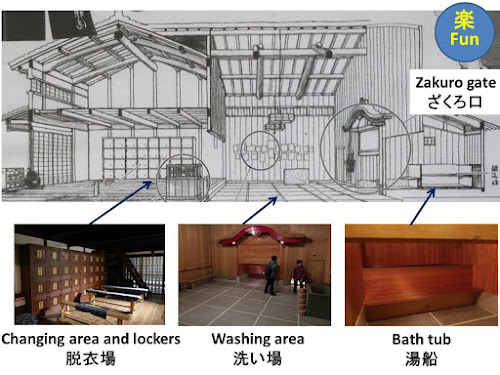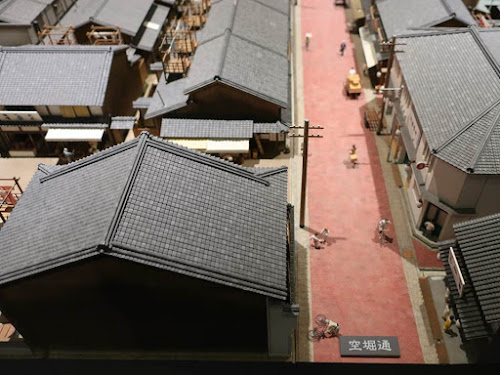This museum was established in 2001.
This is very popular especially among the foreign visitors even now. The Osaka
city in the early 19th century was restored here, it was the Edo period. Visitors can rent kimono (Japanese traditional outfit), and walk
around the old Osaka, and take photos. Those photos might be uploaded on
Instagram or Facebook. Btw, when I visited, the autumn leaves in Midosuj-street
were so beautiful. Living in the cities like Osaka has been fun.
2001年開館だが、今も人気で、海外からの来館者が多い。天保年間の街並みを再現し、着物を貸出して、歩いて写真を撮れる。SNS時代にピッタリである。訪問した時は、御堂筋の黄葉が美しかった。
人の楽しみ、というより暮らしを見る感じだ。故桂米朝さんのガイドを聞きながら回ると、この町に住むことこそが、楽しみになる。一番は風呂屋さん。
From the 10th story of this
museum, we can see the old Osaka city which was different from Edo because
there were many kawara tile roofs which are fire-proof. In Edo, the roofs were
mainly wooden boards. It was common that houses in each city had sliding roofs
in order to exhaust smoke during cooking.
まず、10階から街並みを展望、板葺が多い江戸と異なり、瓦屋根が特徴、でも、開閉式の排気口はしっかりついている。
The picture below shows the En-nich
festival. The female massager was strange because she exposed her chest. Was it
common at that time or was it another service?
街並み展望通路の壁にあった絵。縁日だが、按摩がおかしい。街中で、胸をはだけた女が按摩をしている。人目を気にしない時代か風俗産業か。
I entered the exhibition room which
shows old Osaka in 1830s. The gate on the street was closed at night for
security reason.
1830年代の大阪に入る。表通りへの入口の立派な木戸。夜には閉められる。
 |
| The gate called “Kido”、木戸 |
The photo below shows a main street.
People who rent kimonos enjoyed taking photos. The city is lively every time,
everywhere. There was a public bathhouse on the right.
表通り、着物を借りた人たちが撮影を楽しんでいます。街は楽しい。右側が風呂屋。
Public bath house: It was written on
the fryer “The Japanese are a bath-loving people. --- Osaka where there were
some 119 bathhouses.” and “bathhouses are magnificent recreation centers (for
Japanese) --- Japanese bathhouses are an effective combination of physical
hygiene, mental health, socializing, and recreation” (R. Alcock,the 1st
British Consul-General). It was easy for foreigners to understand the value of
the public bathhouse.
風呂屋:英語パンフレットに、「日本人は風呂好きだ。(中略)大阪には119の風呂屋がある。(中略)日本の風呂屋は、公衆衛生、メンタルヘルス、近所付き合い、リクレーションの効果的なコンビネーションだ」と英国領事が書き残したようだ。
People went to the bath tub through
the gate called Zakuro-guti which was set in order to keep warm air in the bath
tub room. The floor of the washing space was made of stone. In the changing
room, there were lockers with keys.
風呂屋:湯船には、湯気を逃がさないようにした「ざくろ口」をくぐって入る。洗い場は石造り。寒そうだが、暖まれば冷えにくい。脱衣場には盗難防止に配慮した脱衣箱がある。
The photos below are about an accessory
shop which sold combs and so on. Buying and owning accessories are big fun for
ladies. The design of accessories has been more fine and elaborated as time
goes by.
表通りの小間物屋、櫛簪などアクセサリー屋さんである。アクセサリーは女性の大きな楽しみ、時代とともに精緻になってくる。
The photos below show a bookstore. Ukiyoe
which are printings were displayed at the store front. Flyers were hung as
advertisement. There is a book “Enryakuji temple mini guidebook”. I wanted to
read it. Many people like to go to a bookstore and browse books even now. We
can get new information every time at the book store.
本屋:知の楽しみであるが、ポスターともいえる浮世絵が店頭に。書画集などが広告として貼り付けられているが、「比叡山延暦寺小案内記」というのもある。本屋は楽しい
The photos below show “Kara-mono-ya”.
“Kara” is the old name of China, Tang. “Mono” means goods and “Ya” means a
shop. So it is an imported variety goods store. I wonder that people could buy
the imported goods in the Edo period. Tiger fur was displayed. There were no
wild tigers in Japan. Owning good products or rare good is a fun for people.
唐物屋:大阪弁では、からもんや。輸入雑貨である。こんな時代に輸入品が庶民が手に届く店頭に並んだのだろうかと思うが虎の皮まである。良品、珍品を持つのは楽しみである。
There was a pharmacy in which a signboard
of the cure‐all drug stood. The tower shown in the
photo above was a fire watchtower.
合薬屋:立派な看板を上げた薬屋。店内にも万能薬ウルエスの看板がある。また、会所の火の見やぐらが見える。
The photo below shows the inside of
the pharmacy merchant house. The party for six people was prepared. They were
wealthy and enjoyed talking and eating with looking at the garden.
立派な奥座敷。お客様を迎え、集まって食べる、庭を見る。楽しみである。
Next photo shows the bathrooms. In
the pharmacy merchant house, there were two bathrooms for gentlemen and ladies.
There were beautiful basins to wash hands. However, in the
apartment for the ordinary people, they had only one common toilet.
立派な手水鉢がある商家(薬屋)のトイレ、会所のトイレ。小便器もある。美しさもある。そして、長屋のトイレ。江戸と違い、上からのぞけなくて、プライバシーが保護されるそうだ。
This photo shows the gate between
the main street and the backyard where ordinary people lived.
裏長屋への木戸:この先は庶民の世界
I sat on the floor of the apartment
where the paddler who sold vegetables lived with his wife. There was only one
room, so it was a living room, dining room and bedroom. I could see the alley
in front, and I felt someone would talk to me. The distance of the private
space and the public space (alley) was very close, but it was comfortable. Relationship
with neighborhood was a fun basically.
裏長屋:青物振り売りの夫婦の設定。座敷に腰かけてみると、へっつい(かまど)と道が見える。ご近所に声を掛けてもらえそうで、いい感じ。通りと生活の場が近い。人付き合いは、楽しみとする。
This was the room of a performer who was the
master of Gidayuu. Gidayuu is song and music of the puppet show called Bunraku. The room was small, but there were musical instruments and
haori formal wear. That’s cool, I thought.
裏長屋:義太夫の師匠の設定。狭いながらも衝立があり、楽器、羽織もあっていい感じ。物、音楽、楽しみだ。
In the exhibition room at the 8th
floor, we can see a lot of models of Osaka. The photos below show us “Karahori
street”. Shops, main street, backyard and toilets were reproduced well.
8階の展示は、明治以降の大阪。いくつかのモデルが展示されているが、その中から空掘のジオラマ。表店、裏通り、トイレ、しっかり表現されている。裏通りに面してある物干し台が目立つ。
Eleven funs(楽Fun) were found. Visited in December, 2017
http://konjyakukan.com/, accessed in August, 2020
Previous post (Historical museum about Osaka)
:
Next post (Museum at the joyful post town
between Osaka and Kyoto) :
























Comments
Post a Comment